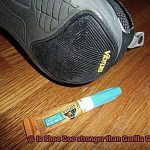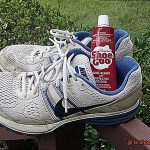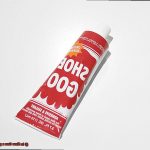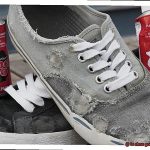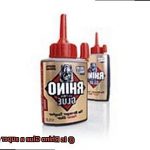Tired of things falling apart? Need a bond that’s as reliable as your morning coffee? Look no further than spray adhesive.
But here’s the burning question: is spray adhesive permanent? Let me spill the beans.
Spray adhesive is all about convenience, versatility, and simplicity. It’s a total game-changer for DIY projects, artsy stuff, and even everyday tasks.
But let’s get real – how long can it really hold things together? Can you trust it to go the distance?
So, grab a seat and stick around – we’re about to get sticky with it.
Different types of spray adhesives and their intended applications
Contents
- 1 Different types of spray adhesives and their intended applications
- 2 Understanding the concept of permanence in spray adhesives
- 3 Factors that affect the permanence of spray adhesive bonds
- 4 Permanent spray adhesives: Features and benefits
- 5 Temporary and repositionable spray adhesives: When to use them
- 6 Tips for achieving a strong and permanent bond with spray adhesive
- 7 Common challenges with spray adhesive permanence and how to overcome them
- 8 Maintaining the permanence of spray adhesive bonds over time
- 9 Conclusion
Step into the captivating world of spray adhesives, where crafting, woodworking, and upholstery projects become a breeze.
With an array of options available, how do you select the perfect glue for your project? Prepare to embark on a journey through the diverse types of spray adhesives and their intended applications.
Whether you seek temporary flexibility or a steadfast permanent hold, we have the ultimate guide to satisfy your adhesive desires.
Repositionable Spray Adhesive:
For the meticulous perfectionists among us who crave rearrangement until it’s just right, repositionable spray adhesive is your trusted companion. This adhesive offers temporary bonding that allows you to effortlessly reposition materials before it solidifies permanently. Perfect for crafts, scrapbooking, or any project demanding flexibility.
Permanent Spray Adhesive:
When durability and longevity are paramount, turn to permanent spray adhesive. Once applied, it forms an unyielding bond that resists repositioning or removal without causing damage. Ideal for woodworking, upholstery, and fabric bonding, this adhesive ensures your projects remain intact for years to come.
High-Temperature Spray Adhesive:
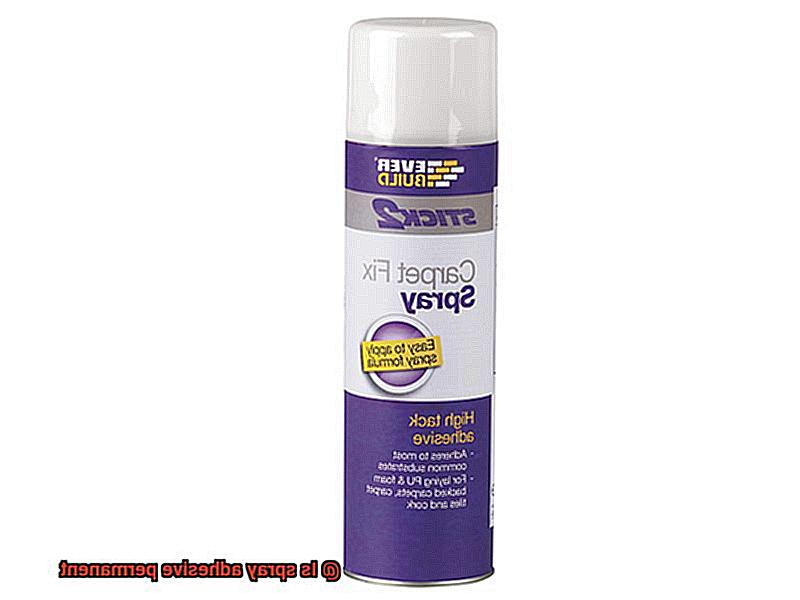
If your endeavors involve automotive or industrial applications requiring heat resistance, high-temperature spray adhesive is your steadfast ally. Formulated specifically to withstand scorching temperatures, it effortlessly adheres to headliners, carpets, and insulation materials without sacrificing bond strength.
Foam and Fabric Spray Adhesive:
Enter the realm of foam and fabric spray adhesives, meticulously crafted to unite foam, upholstery, and fabric materials. These adhesives provide a robust yet flexible bond that allows for free movement and expansion of these materials. Whether upholstering furniture or designing bespoke cushions, this adhesive ensures an unbreakable hold.
Heavy-Duty Spray Adhesive:
For those audacious projects that demand bonding heavy or challenging materials, heavy-duty spray adhesive is the answer to your prayers. It fearlessly tackles metals, plastics, and rubber with ease, providing a bond that withstands substantial stress and strain. Perfect for industrial or DIY applications that demand unwavering strength.
Multipurpose Spray Adhesive:
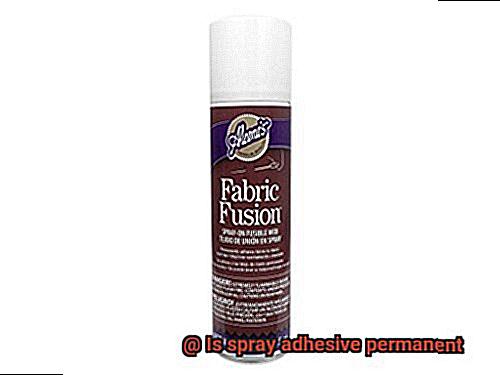
Seeking an adhesive that conquers all? Look no further than multipurpose spray adhesive. This versatile option strikes a balance between temporary and permanent bonding, making it suitable for a wide range of projects. From crafting to household repairs, this all-in-one adhesive is an indispensable tool in your arsenal.
Understanding the concept of permanence in spray adhesives
Step into a world where materials bond effortlessly, creating lasting connections that withstand the test of time. Spray adhesives have revolutionized the way we join surfaces together, offering a wide range of applications across industries. Understanding the concept of permanence in these adhesives is crucial for achieving strong and long-lasting bonds. Join us on a captivating journey as we explore the factors that contribute to permanence in spray adhesives, unveiling the secrets behind their power to create enduring connections.
The Power of Formulation:
Spray adhesives come in a multitude of formulations, each holding its own unique level of permanence. Temporary adhesives, with their low tack, are perfect for projects that require easy repositioning or quick removal. In contrast, permanent adhesives offer an unbreakable bond that defies separation. By understanding your project’s needs, you can choose the perfect adhesive formulation to achieve optimal permanence.
Compatibility is Key:
Materials have their own personalities, and spray adhesives know how to speak their language. Different adhesives excel on specific surfaces: porous materials like wood or fabric thrive under certain formulas, while non-porous surfaces like metal or plastic require adhesive mastery of their own. Ensuring compatibility between adhesive and material is the secret ingredient to creating bonds that conquer time.
Permanence in Any Environment:
The permanence of a spray adhesive bond is not immune to the elements. Temperature, humidity, and UV light all play a role in determining the longevity of the connection. Extreme conditions can weaken bonds, causing them to crumble under pressure. Awareness of environmental factors allows us to fortify our bonds against the ravages of time.
Mastering Application Techniques:
To achieve permanence, proper application techniques are vital. Manufacturers provide instructions for a reason: to guide us in applying the right amount of adhesive and ensuring its even distribution. Striking the perfect balance is an art, as too little adhesive results in weak bonds, while excess can lead to residue buildup and potential bond failure. Mastery of application techniques unlocks the true potential of spray adhesives.
Factors that affect the permanence of spray adhesive bonds
Spray adhesives have revolutionized the world of crafting, DIY, and professional projects. These magical potions create bonds so strong and durable, you can practically feel the materials melding together. But what factors influence the permanence of these adhesive bonds? In this blog post, we will unlock the secrets behind achieving long-lasting spray adhesive bonds by exploring key factors and sharing expert tips.
Surface Preparation:
Imagine a painter faced with a dusty canvas – the same applies to spray adhesives. A clean surface is essential for a bond that withstands the test of time. Rid the surface of dust, oils, grease, or any contaminants by wiping it with a clean cloth or using an appropriate cleaning agent. Surface preparation sets the stage for an unbreakable bond.
Material Compatibility:
Choosing the right adhesive for your project is paramount. Just as each superhero has their unique power, different adhesives are designed for specific materials – wood, fabric, metal, plastic, you name it. Pick an adhesive that plays well with both surfaces you intend to bond. This ensures optimal adhesion and minimizes the risk of weak or failed bonds.
Application Technique:
The way you wield your spray adhesive wields its influence on bond permanence. Embrace instruction-manual discipline, ensuring even coverage and applying the recommended amount of adhesive. Too little adhesive yields weak bonds, while excess adhesive oozing out can lead to potential failure over time.
Temperature and Humidity:
Environmental conditions hold sway over spray adhesive curing. Some adhesives crave specific temperature ranges for optimal bonding and curing. High humidity slows drying, while low humidity accelerates curing, both compromising bond strength. Respect these factors and adhere to recommended environmental conditions during application.
Time for Bonding:
Patience, my friend, is the key to permanent bonds with spray adhesives. Allow sufficient time for the adhesive to cure fully before subjecting the bonded surfaces to stress or load. Rushing the process jeopardizes bond durability.
Exposure to Moisture and Heat:
Consider the battlefield your bonded materials will face. If they’re destined for moisture or heat exposure, select an adhesive that can withstand these conditions. Frequent encounters with water or high temperatures can weaken the adhesive, causing a loss of bond strength over time.
Permanent spray adhesives: Features and benefits
These extraordinary potions are the ultimate solution for anyone tired of traditional adhesives that just can’t seem to hold up. Whether you’re a DIY enthusiast or a seasoned professional, these adhesives are a must-have in your arsenal.
One of the standout features of permanent spray adhesives is their ability to create a strong and durable bond. No more worrying about your projects falling apart. These adhesives have been specially formulated to withstand the harshest environmental conditions, from scorching heat to relentless moisture and even UV exposure. So whether you’re working on a woodworking project under the blazing sun or crafting something that will be exposed to the elements, permanent spray adhesives have got you covered.
Versatility is another key feature of these adhesive wonders. They can be used on a wide variety of materials, including paper, fabric, wood, metal, and plastic. Whether you’re working on a delicate scrapbooking project or constructing sturdy furniture, permanent spray adhesives are the perfect companion.
But wait, there’s more. These adhesives offer instant tackiness, allowing you to position and reposition your materials before the bond fully sets. This flexibility is a game-changer when it comes to getting things just right. And if you’re in a hurry to finish your project, permanent spray adhesives have got your back with their quick drying time.
Applying these adhesives is a breeze too. Many come in convenient aerosol cans with a nozzle for easy application. Say goodbye to messy glue bottles and hello to hassle-free bonding.
One of the best things about permanent spray adhesives is their ability to create clean and invisible bonds. No more unsightly residue or marks on your surfaces. Plus, some of these adhesives are non-toxic and safe for use on projects involving children or food-related items. Talk about peace of mind.
Whether you’re working on indoor or outdoor projects, permanent spray adhesives are the answer. Their reliability, convenience, and durability make them a go-to choice for a wide range of bonding needs.
Temporary and repositionable spray adhesives: When to use them
These magical sprays are like the superheroes of the adhesive realm, offering flexibility, versatility, and an easy way to experiment with your crafts and projects.
So, when should you reach for these temporary wonders? Let’s dive into the endless possibilities.
- Crafts and DIY projects: If you’re into crafts, DIY projects, or scrapbooking, temporary spray adhesives are your new best friend. They’re perfect for attaching lightweight materials like paper, fabric, or photos temporarily. Need to stick a photo onto a scrapbook page without committing to its placement just yet? Temporary spray adhesive is here to save the day.
- Repositionable power: But wait, there’s more. Repositionable spray adhesives take things up a notch. They not only provide a temporary bond but also allow you to adjust the position of your bonded materials even after application. This makes them a dream come true for activities like scrapbooking or creating collages. You can experiment with different layouts and move things around until you find the perfect arrangement.
- Stencils and masks made easy: And let’s not forget about stencils and masks. Temporary spray adhesives are fantastic for creating these handy tools. Simply spray a light coat onto the back of your stencil or mask material, press it onto your project surface, and voila. You have a temporary guide that can be easily removed once you’ve achieved the desired effect.
It’s important to note that while these sprays are great for temporary applications and experimentation, they may not provide the same level of durability as permanent adhesives. So, if you’re working with heavy or load-bearing materials that require a strong bond, you might want to explore other options.
Remember, always follow the manufacturer’s instructions when using temporary and repositionable spray adhesives to ensure proper application and avoid any potential issues. Embrace the flexibility and creativity that these sprays offer. Your crafts and projects will thank you for it.
Tips for achieving a strong and permanent bond with spray adhesive
Spray adhesive is a versatile tool that can be used in a wide range of projects. However, to achieve a strong and permanent bond, proper technique and attention to detail are essential. In this article, we will provide expert tips and techniques to help you achieve a durable and long-lasting bond with spray adhesive.
Surface Preparation:
Properly preparing the surfaces is crucial for achieving a strong bond. Start by cleaning them thoroughly to remove any dirt, dust, or grease that may hinder adhesion. Use a mild detergent or solvent and ensure the surfaces are completely dry before applying the adhesive.
For smooth surfaces like glass or metal, lightly sanding them can create a better grip for the adhesive. Adequate surface preparation ensures a clean and strong foundation for the adhesive to adhere to.
Adequate Coverage:
To achieve a strong bond, it is important to apply the spray adhesive evenly and thoroughly. Ensure that the entire surface area is covered with a consistent layer of adhesive. Pay special attention to corners and edges, as these areas are more prone to lifting or peeling if not bonded properly.
Applying multiple thin coats of adhesive is often more effective than one heavy coat, as it allows for better adhesion and reduces the risk of uneven coverage.
Proper Application Technique:
The application technique plays a crucial role in achieving a strong bond. Maintain the correct distance between the nozzle and the surface being bonded, as specified by the manufacturer’s instructions. Spraying too close or too far away can result in uneven coverage or inadequate bonding. Apply the adhesive in smooth, even strokes, moving from one end of the surface to the other. This ensures consistent coverage and minimizes the risk of air bubbles or gaps.
Allow Sufficient Drying Time:
After applying spray adhesive, it is crucial to allow sufficient drying time before joining the surfaces together. The drying time varies depending on factors such as temperature and humidity, so it is essential to follow the manufacturer’s instructions.
Rushing the bonding process by joining the surfaces too soon can weaken the bond. Patience is key to achieving a strong and lasting bond.
Apply Pressure:
Once the surfaces have been joined, applying pressure helps enhance the bond strength of the spray adhesive. Use tools such as clamps, weights, or rollers to apply even pressure across the entire bonded area. This ensures that the adhesive fully adheres and eliminates any air pockets or gaps that may compromise the bond. Applying pressure for a recommended duration, as specified by the manufacturer, allows the adhesive to cure properly.
Common challenges with spray adhesive permanence and how to overcome them
We understand your frustration when it comes to dealing with adhesive that just doesn’t stick around. But fear not. We’re here to tackle the common challenges with spray adhesive permanence and equip you with practical solutions to overcome them. So let’s dive into this sticky situation and find some answers.
One of the most common challenges is the dreaded poor initial bond. You know the feeling – you spray the adhesive, but it just doesn’t seem to adhere strongly enough. To conquer this challenge, start by preparing your surface properly. Wipe away any dust or debris and ensure it’s clean and dry. This paves the way for a stronger bond. Additionally, applying multiple thin layers of adhesive and allowing each layer to dry completely before adding the next can improve the initial bond significantly.
Now let’s turn up the heat, quite literally, as we tackle the next challenge – lack of heat resistance. It’s a real bummer when your bonded materials start to loosen or separate under high temperatures. But worry not. To combat this issue, seek out spray adhesives specifically designed for high-temperature applications or ones that explicitly mention heat resistance on their packaging. These specialized adhesives are formulated to withstand the scorching temperatures that life may throw at your projects. Remember, proper application techniques and ample drying time are crucial for achieving maximum heat resistance.
Ah, compatibility – or lack thereof – with certain materials can be another hurdle we encounter with spray adhesive permanence. Smooth or non-porous surfaces like glass or metal can pose a real challenge for these adhesives. To triumph over this challenge, select an adhesive that is compatible with the materials you’re working with. Read the product label carefully and, when in doubt, perform a test on a small inconspicuous area before committing to covering the entire surface. This cautious approach will save you from any unpleasant surprises down the line.
Last but not least, let’s shine a light on the impact of environmental factors on spray adhesive permanence. High humidity levels can slow down drying time, while extreme temperatures and UV exposure can degrade the adhesive over time. To combat these challenges, be mindful of your workspace environment. Ensure proper ventilation and maintain moderate humidity levels. If working outdoors, choose a day with mild temperatures and avoid direct exposure to sunlight. Additionally, select an adhesive that offers good resistance to UV rays for outdoor applications. By taking these environmental factors into account, you’ll enhance the longevity of your adhesive bond.
Maintaining the permanence of spray adhesive bonds over time
Ensuring the long-lasting durability of spray adhesive bonds is a complex task that demands attention to detail and a keen understanding of the factors that influence bond permanence. Let’s embark on a journey to unravel the secrets behind maintaining the strength and reliability of spray adhesive bonds over time.
The first step in this adventure lies in understanding the role that different materials play in bond permanence. Porous materials, like fabric and wood, possess the innate ability to absorb adhesive, resulting in a stronger and more resilient bond. However, non-porous materials, such as metal or plastic, require additional effort to achieve lasting adhesion. To conquer this challenge, we must explore innovative techniques and strategies to ensure that spray adhesives form a steadfast bond with these stubborn surfaces.
Next, we encounter the critical importance of proper surface preparation. Picture a masterpiece being created on a dirty canvas – it’s destined for disaster. Similarly, applying adhesive on a surface tainted by dust, grease, or grime would be an exercise in futility. To achieve adhesive longevity, we must cleanse our surfaces diligently, ensuring they are dry and free from any contaminants that could hinder adhesion. In some cases, specialized treatments like sanding or priming may be necessary to unlock the full potential of our adhesives. The path to success lies in faithfully following the manufacturer’s instructions on surface preparation.
As we venture deeper into our quest for bond permanence, we encounter a formidable adversary – environmental conditions. Temperature and humidity are powerful forces that can either bolster or undermine our efforts. Extreme temperatures, whether scorching heat or icy cold, have the potential to weaken or even obliterate adhesive bonds. Similarly, high humidity levels can disrupt the curing process of certain adhesives, resulting in diminished bond strength. To triumph over these challenges, we must be mindful of the environmental conditions during application and ensure they align with the recommended range specified by adhesive manufacturers.
Our journey would be incomplete without addressing the crucial role of application technique. Imagine an artist haphazardly applying brushstrokes to their canvas – the result would be a disjointed and unimpressive piece. Similarly, uneven or excessive application of spray adhesive can lead to weak areas and poor adhesion. To achieve a masterpiece in bond permanence, we must adhere to the manufacturer’s guidelines on application techniques. By maintaining a proper spraying distance and aiming for even coverage, we can create a uniform coating that ensures a strong and lasting bond.
Selecting the right type of spray adhesive is our next challenge on this quest. Every adhesive possesses unique properties and strengths, designed for specific materials or purposes. Flexibility, resistance to heat or moisture, and the intended lifespan of the bond are all factors to consider when making our selection. By choosing an adhesive that aligns with our needs and requirements, we lay the foundation for maintaining a long-lasting bond.
IPd8vzIZpbE” >
Conclusion
Spray adhesive is a versatile and convenient product that many people use for various projects. But the burning question remains: is spray adhesive permanent? Well, the answer is not as straightforward as you might think. While spray adhesive can provide a strong bond, its permanence ultimately depends on several factors.
Firstly, the type of surface you are working with plays a crucial role in determining the longevity of the adhesive bond. Some surfaces, like paper or cardboard, may not require a permanent bond, making spray adhesive an excellent choice. However, if you’re working with materials like metal or glass that require a more permanent hold, you may need to explore other options.
Additionally, the quality and brand of spray adhesive can greatly affect its permanence. Cheaper adhesives might not have the same strength and durability as higher-end brands. So if you’re looking for a long-lasting bond, it’s worth investing in a reputable brand that has been tested and proven to deliver reliable results.
Furthermore, environmental factors can also impact the permanence of spray adhesive. Extreme temperatures or humidity levels can weaken the bond over time. So if your project will be exposed to harsh conditions, it’s essential to choose an adhesive specifically designed to withstand those challenges.
In conclusion, while spray adhesive can offer a strong bond for many applications, its permanence varies depending on surface type, adhesive quality, and environmental conditions. It’s crucial to consider these factors when choosing an adhesive for your project to ensure your hard work stands the test of time.


